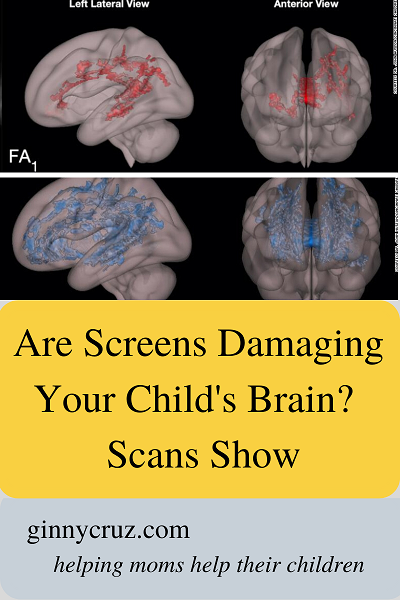Are Screens Damaging Your Child’s Brain? Scans Show
Today’s young children are growing up with screens that follow them everywhere—tablets, smartphones, TVs, etc. Since 2016, the American Academy of Pediatricians (AAP) has recommended guidelines for children’s exposure to screens. However, truth be told, most families either don’t know about those or choose to disregard them.
What’s the harm?”
In a groundbreaking study published in November of 2019, 47 preschool children (ages 3- 5) were evaluated. The children who were on screens more than the time recommended by the AAP showed (see photo with blue color above) diminished white matter formation in the areas of the brain associated with language and literacy. Those children who were not on screens and, instead, played with real-world toys and books had strong white matter formation (see photo with red color above).
“This is the first study to document associations between higher screen use and lower measures of brain structure and skills in preschool-aged kids,” said lead author Dr. John Hutton, a pediatrician and clinical researcher at Cincinnati Children’s Hospital. “This is important because the brain is developing the most rapidly in the first five years,” Hutton said. “That’s when brains are very plastic and soaking up everything, forming these strong connections that last for life.”
The study demonstrated not only physical changes within the children’s brain but also showed lower brain processing speed, diminished language, and literacy skills.
Studies have already demonstrated excessive TV viewing is linked to decreased attention spans, increased rates of obesity, and behavioral problems. Correlations have also been shown between excessive screen time and delays in language, poor sleep, impaired executive functions, and diminished relationships between the parent and child.
This is all very disturbing scientific information especially when you realize “About 90% are using screens by age one,” said Hutton, who published a number of studies that used MRIs to research the impact of reading versus screen use by kids. “We’ve done some studies where kids are using them by 2 months old to 3 months old.”
What is white matter and what is its function?
The brain is composed of gray matter and white matter. On the outer surface is the gray matter which is made up of brain cells. Some brain cells store memories, others store words, motor actions, etc. These gray cells communicate with other gray cells via white matter. Think of white matter as cables or highways. Strong and healthy white matter allows various areas of the brain to communicate efficiently and rapidly to execute actions or decisions. Disorganized white matter makes it more difficult for the areas of the brain to communicate and perform tasks.
Based on this very rudimentary explanation of an extremely complex system, the blue brain pictured above is going to have more trouble communicating amongst the various areas of the brain and, therefore, the child will perform less well on speaking, reading, understanding what’s said and following directions, and staying focused on a task. On the other hand, the red brain will take in spoken language, social cues, and sensory experiences and process a response faster and more accurately. This child will likely perform better in school than the child with the blue brain.
Are screens damaging your child’s brain?
The researchers make clear the findings of this study demonstrate the need for further study. Their position is that the brain of a child who is on screens a lot is not actually damaged but is not forming correctly. This conclusion seems to be an academic way of not taking a firm stand. The definition of the word damage states “physical harm caused to something in such a way as to impair its value, usefulness, or normal function.” These findings seem to conclude the brain of a child who spends a lot of time playing on screens is, indeed, not performing the normal functions of a child that age. Therefore, it meets the definition of damaged.
What these brain changes will mean long term for the child is not known.
What’s the takeaway?
Current science is clear—screens are not entirely safe for your young child, regardless of what they are watching. Not only is the development of your child’s brain affected, but their eyes are too. Sleep patterns and inactivity are also impacts of too much screentime.
The AAP’s screen time guidelines are worth heeding. Again, click here for the recommended limits for screen viewing.
Actions to take now
- Track your child’s actual screen time. Here’s a helpful tracker. (Available in Spanish)
- Create a family media plan. Here’s a great resource. (Available in Spanish)
- Create areas or have toys available in your home to keep your child occupied reading books, building with blocks, talking with dolls, running and climbing outside, painting or chalk play, riding toys, singing songs, and playing with others.
- Stay focused on how important to your child it will be for their brain to form in the best way possible. A child that starts out behind usually stays behind.
What’s holding you back from restricting the use of screens in your home?
(Photos courtesy of John S. Hutton, MD)
Related reading:
More Screen Time for Toddlers is Tied to Poorer Development a Few Years Later
Why Kids Need to Spend Time in Nature

